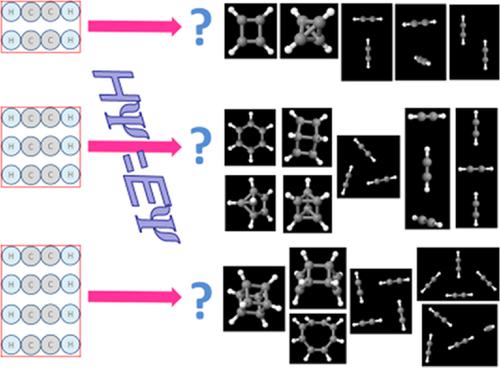当前位置:
X-MOL 学术
›
J. Comput. Chem.
›
论文详情
Our official English website, www.x-mol.net, welcomes your
feedback! (Note: you will need to create a separate account there.)
Quantum Chemical Exploration of Intermolecular Reactions of Acetylene
Journal of Computational Chemistry ( IF 3.4 ) Pub Date : 2019-12-02 , DOI: 10.1002/jcc.26120 Koichi Ohno 1, 2 , Takuto Oki 3 , Hideo Yamakado 3
Journal of Computational Chemistry ( IF 3.4 ) Pub Date : 2019-12-02 , DOI: 10.1002/jcc.26120 Koichi Ohno 1, 2 , Takuto Oki 3 , Hideo Yamakado 3
Affiliation

|
Quantum chemical explorations of potential energy surfaces showed that acetylene produces various products starting from molecular arrays in short distances of 1.3–2.5 Å. Arrays of (C2H2)2 gave cyclobutadiene, tetrahedrane, and acetylene dimers. Arrays of (C2H2)3 gave benzene, prismane, benzvalene, Dewar benzene, and acetylene trimers. Arrays of (C2H2)4 gave cubane, cyclooctatetranene, and acetylene tetramers. Different forms of initial arrays yielded different sets of products; a parallel array of two monomers gave cyclobutadiene, whereas a cross array gave tetrahedrane. Initial molecular arrays with unusually close contacts were estimated to require local forces of 1–9 × 10−8 N. © 2019 Wiley Periodicals, Inc.
中文翻译:

乙炔分子间反应的量子化学探索
势能面的量子化学探索表明,乙炔从 1.3-2.5 Å 的短距离分子阵列开始产生各种产物。(C2H2)2 阵列得到环丁二烯、四面体和乙炔二聚体。(C2H2)3 阵列得到苯、棱柱烷、苯并瓦烯、杜瓦苯和乙炔三聚体。(C2H2)4 阵列产生立方烷、环辛四烯和乙炔四聚体。不同形式的初始数组产生不同的产品集;两个单体的平行排列产生环丁二烯,而交叉排列产生四面体。据估计,具有异常紧密接触的初始分子阵列需要 1–9 × 10–8 N 的局部力。 © 2019 Wiley Periodicals, Inc.
更新日期:2019-12-02
中文翻译:

乙炔分子间反应的量子化学探索
势能面的量子化学探索表明,乙炔从 1.3-2.5 Å 的短距离分子阵列开始产生各种产物。(C2H2)2 阵列得到环丁二烯、四面体和乙炔二聚体。(C2H2)3 阵列得到苯、棱柱烷、苯并瓦烯、杜瓦苯和乙炔三聚体。(C2H2)4 阵列产生立方烷、环辛四烯和乙炔四聚体。不同形式的初始数组产生不同的产品集;两个单体的平行排列产生环丁二烯,而交叉排列产生四面体。据估计,具有异常紧密接触的初始分子阵列需要 1–9 × 10–8 N 的局部力。 © 2019 Wiley Periodicals, Inc.











































 京公网安备 11010802027423号
京公网安备 11010802027423号